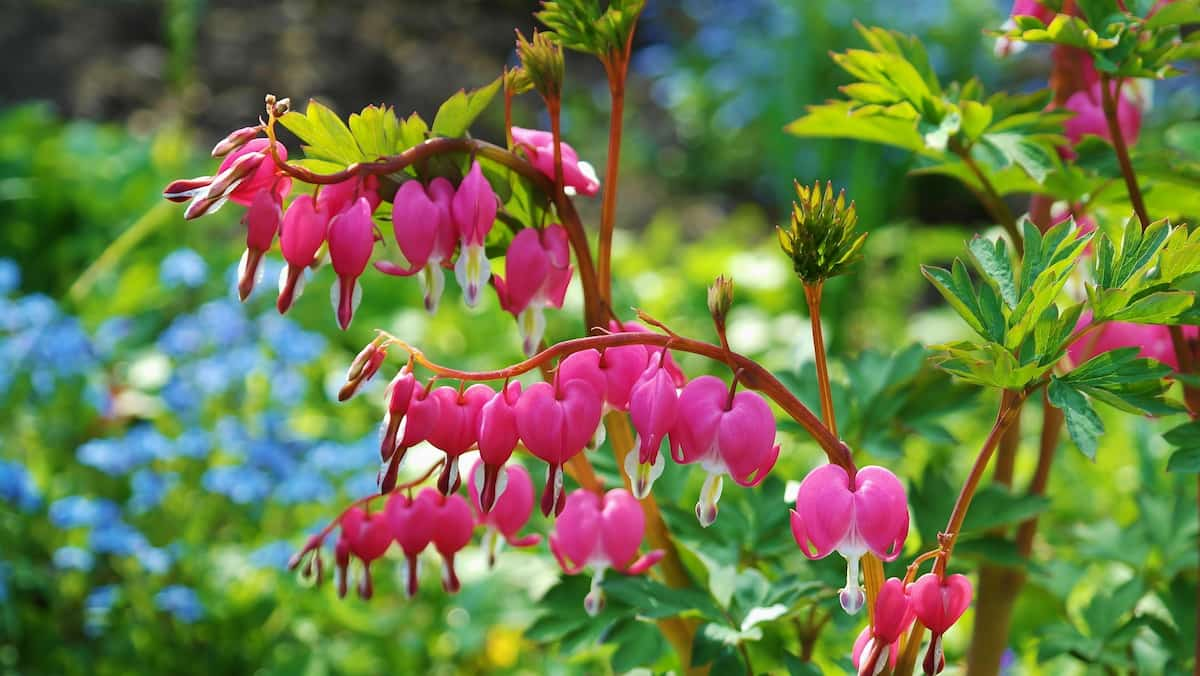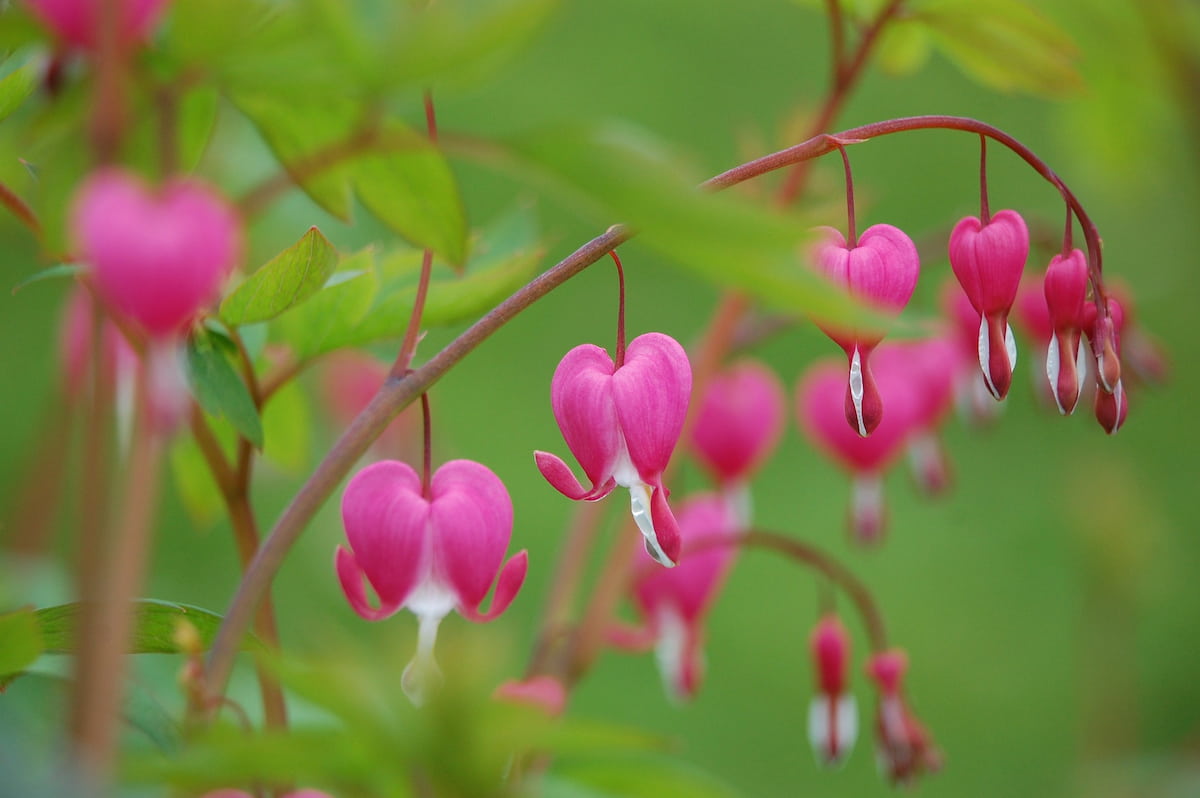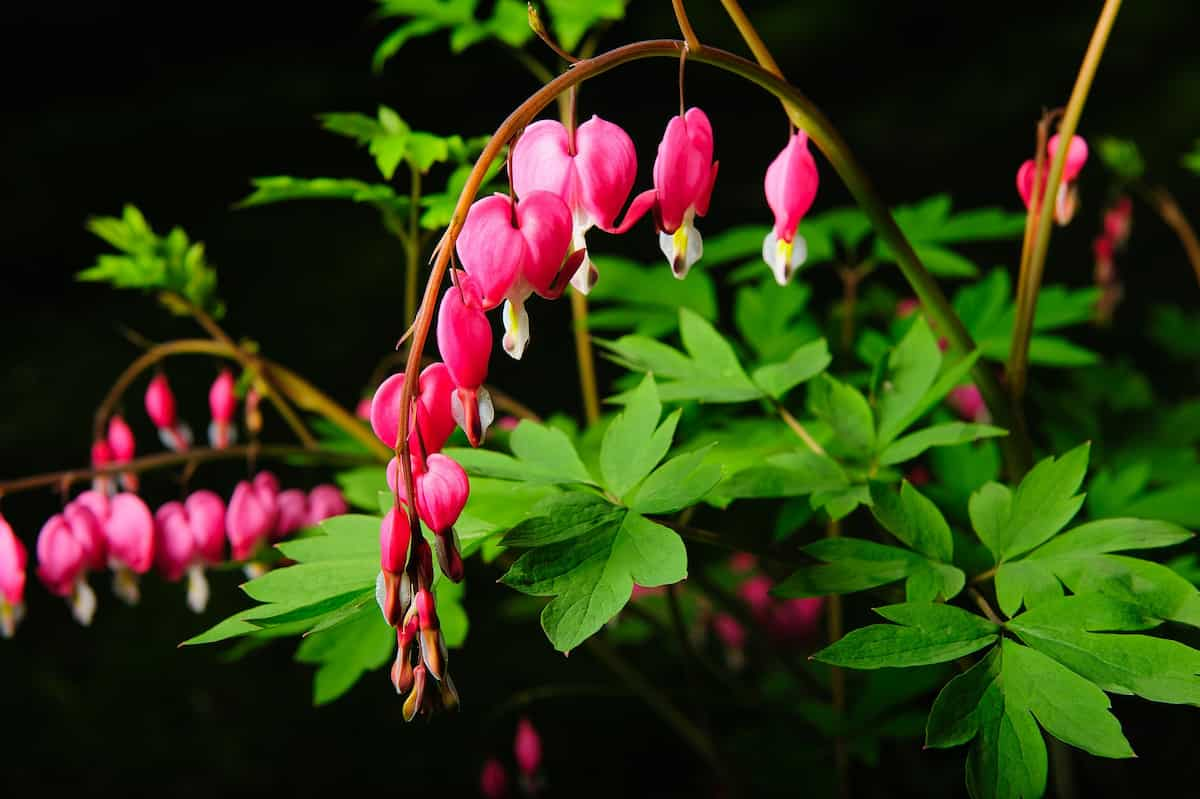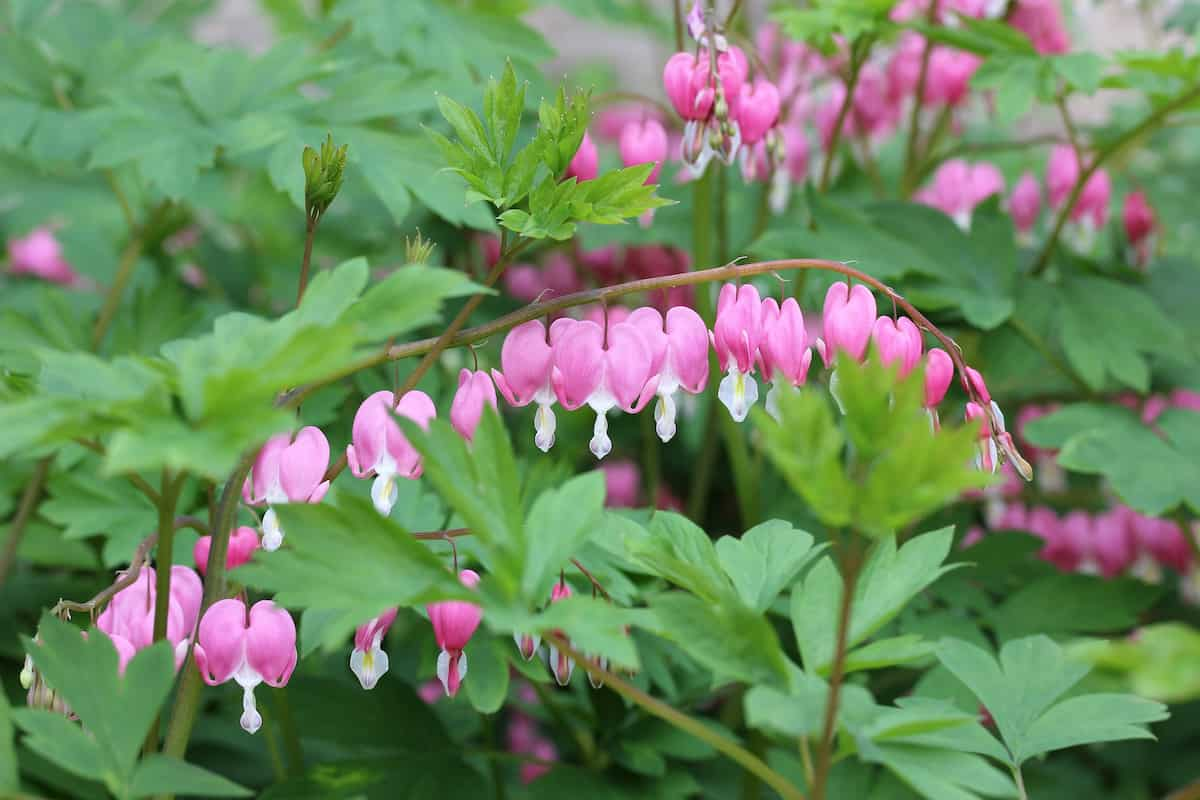A Bleeding heart is a beautiful, old-fashioned flower that’s easy to grow and care for. The plant gets its name from the heart-shaped flowers, which appear to be Bleeding. It blooms in the spring and summer, and its flowers are lovely shades of pink and red. There are many Bleeding heart flower plants, each with its unique appearance and set of characteristics.

When choosing a Bleeding heart plant for your garden, it is important to consider the flowers’ size, shape, color, and overall hardiness. With so many beautiful options available, it is easy to find the perfect Bleeding heart plant for any garden setting.
How to grow and care for Bleeding Heart plant
Bleeding heart plant varieties
- Amore pink – If you’re looking for a unique color in your Bleeding heart flower, the Amore pink variety is an attractive option. This flower gets its name from its heart-shaped petals, a lovely pink shade.
- Aurora – The Aurora Bleeding heart is a beautiful variety characterized by its red and white flowers. This plant blooms in the spring and summer, and its flowers are typically 2-3 inches in diameter. The Aurora Bleeding heart is a hardy plant that can tolerate many growing conditions, making it a great choice for gardeners of all experience levels.
- Candy Hearts – Candy Hearts are among the most popular Bleeding heart flower plants. Candy hearts have a long blooming period and produce pale pink or white flowers.
- Gold Heart – There are many Bleeding heart plants, but they all share the common trait of having heart-shaped flowers. Gold is the most popular Bleeding heart type, a hybrid plant created by crossing two other types of Bleeding hearts. The Gold heart has large, bright green leaves and stunning red or pink flowers.
- Red Fountain – It is a perennial plant that can grow to about two feet tall. The leaves of the Red Fountain are heart-shaped, and the flowers are a deep red.
- Silversmith – If you’re looking for a plant with gorgeous, heart-shaped flowers, you should consider the Silversmith Bleeding heart. This perennial has clusters of delicate pink or white blooms that appear in spring and summer. The Silversmith Bleeding heart is a low-maintenance plant that does well in shady areas and can tolerate drought.
- Snowdrift – The Snowdrift variety is an attractive option for Bleeding heart flower plants. This plant gets its name from its large, pure white flowers that resemble delicate snowflakes. The Snowdrift Bleeding heart is a relatively new hybrid, prized for its ability to bloom continuously throughout the summer months.
In case you missed it: How to Grow and Care for Ageratum Plant: A Beginners Guide

Climate suitable for growing Bleeding Heart plant
The best climate for growing Bleeding heart plants is cool and moist. They prefer partial shade but can also tolerate full sun. If you live in hot summer, it’s best to grow them in a shady spot in your garden. The Bleeding heart flower prefers to grow in shady areas with moist soil. It is important to provide adequate drainage for the plant as it does not tolerate standing water.
The ideal temperature range for growing a Bleeding heart plant is between 18-24°C. Regarding light requirements, Bleeding heart flower plants prefer partial shade or dappled sunlight. They can tolerate full sun, but it’s best to avoid the direct midday sun, which can cause the leaves to scorch. If you’re growing Bleeding heart plants indoors, place them in a spot where they’ll receive bright, indirect light.
Soil requirement for growing Bleeding Heart plant
The best soil for growing a Bleeding heart plant is high in organic matter and drains well. A sandy or clay loam soil with a pH of 6.5 to 7.5 is ideal. If your soil is heavy and poorly drained, you can improve it by amending organic matter such as compost or peat moss. When preparing the planting bed, add compost or other organic matter to help improve drainage and aeration. If you have heavy clay or very sandy, you may consider amending it with some organic matter before planting.
Water requirement for growing Bleeding Heart plant
Water is important for growing plants, and a Bleeding heart is no different. These beautiful plants need moist soil to thrive, so water them regularly. Water them deeply, allowing the soil to dry out somewhat between watering to prevent root rot. During the spring and summer months, Bleeding heart flower plants must be watered regularly, ensuring the soil stays moist but not soggy. However, in the fall and winter months, you can cut back on watering somewhat as the plant will enter a dormant state. Once every week or two should suffice during this time.
In case you missed it: How to Grow and Care for ZZ Plants Indoors: A Beginners Guide

Propagating Bleeding Heart plant
From cutting
- To propagate your Bleeding heart plant, you will need to take a cutting from an existing plant. A cutting should be taken from a healthy, established plant at least one-year-old. Cuttings should be taken from new growth, not old wood. The cutting should be about 4-6 inches long and have several leaves.
- To take a cutting, first, sterilize your pruning shears by wiping them down with rubbing alcohol. This will help prevent the spread of disease. Cut the stem at a 45-degree angle below a leaf node (where the leaf meets the stem). Remove the lower leaves, leaving only 2 to 3 at the top. Dip the end of the cutting stem in rooting hormone powder or gel (this step is optional but will help promote root growth). Place the cutting in a pot filled with moistened potting mix. Be sure to water the potting mix thoroughly before adding the cutting so that it is not too dry or too wet.
- Place the pot in a warm, bright location out of direct sunlight. After 3 to 4 weeks, roots should start to form, and new growth will appear on the plant. Once roots have developed and new growth is visible, you can transplant your new Bleeding heart plant into its pot or garden bed.
In case you missed it: How to Grow and Care for Arrowhead Vines Indoors

From division
You can propagate a Bleeding heart flower plant through division. Using a sharp knife or spade, carefully divide the root ball into sections, ensuring each section has at least one good-sized root system. Plant the divisions in prepared soil and water well. Until new growth appears, keep the soil moist.
From seed
One of the most rewarding ways to propagate Bleeding heart flowers is from seed. Start by collecting seeds from an existing plant. You can do this by gently shaking the flower heads or snipping off the seedpods once they have dried. Once you have collected your seeds, it’s time to sow them. Bleeding heart seeds need darkness to germinate, so the best way to sow them is by placing them in a pot or tray of moistened soil and then covering them with a layer of black plastic or dark cardboard.
Put your pots or tray in a warm, dark place and check on them regularly to ensure the soil stays moist. After a few weeks, you should see tiny seedlings emerging from the soil. Once your seedlings are big enough to handle, transplant them into pots filled with fresh potting mix.
Transplanting Bleeding Heart seedlings
To transplant Bleeding heart seedlings, prepare the planting area by loosening the soil and removing any weeds. Then, dig a hole larger than the seedling’s roots using a shovel or trowel. Gently place the seedling in the hole, backfill it with soil, and lightly tamp it down. Bleeding hearts are best transplanted in early spring before they begin actively growing. However, if you must transplant during the growing season, do so in late summer or early fall. This will give the plant time to establish roots before winter sets in.
In case you missed it: How to Grow and Care for Chinese Evergreen Indoors: Tips and Ideas for Beginners

Bleeding heart plant care
Fertilizer requirement for growing Bleeding Heart plant
If you want beautiful blooms on your Bleeding heart plant, you must fertilize it regularly. The best fertilization time is during the growing season, typically spring to summer. You can use any fertilizer, but make sure it is specifically for flowering plants. You should also water the plant before and after applying the fertilizer.
Different types of fertilizer can be used on Bleeding heart flower plants, but the best type is a slow-release fertilizer. This fertilizer will gradually release nutrients into the soil over a period, which is ideal for plants that need a consistent supply of nutrients. Another benefit of using a slow-release fertilizer is that it helps to reduce the risk of burning the roots of the plant.
Pruning Bleeding Heart plant
Pruning keeps the plant healthy and promotes new growth. Bleeding heart plants can be pruned in the spring or summer. The perfect time to prune is after the plant has flowered. To prune, cut back the stems to just below where the leaves attach. This will promote new growth and prevent the plant from getting too leggy.
Bleeding Heart plant care in winter
Assuming you are in a region with cold winters, there are a few things you can do to care for your Bleeding heart flower plant during the winter months. First, make sure you mulch around the base of the plant to protect the roots from freezing. You can also cover the plant with a burlap cloth if you expect extremely cold temperatures or harsh weather conditions.
During the winter, Bleeding heart plants will go dormant and not need as much water. However, you should still check on the plant regularly and water it if the soil is dry. If possible, move the plant to a protected area during winter, such as a garage or porch, where it will be out of direct sunlight and wind.
In case you missed it: How to Grow and Care for Ocotillo in Pots: A Beginners Guide

Pests and diseases of Bleeding Heart plant and their control
Aphids are often found in large groups on the bottom side of leaves, where they suck plant juices. While slugs and snails may seem harmless, they can cause serious damage to Bleeding heart flower plants. Japanese Beetles are sap-sucking insects that feed on the leaves of Bleeding heart flower plants. The beetles are most active in late spring and early summer and can cause significant damage to the plant if left unchecked. Earwigs can be a nuisance to gardeners, as they are attracted to Bleeding heart flowers. In severe cases, earwigs can kill a Bleeding heart plant.
You can do several things to prevent pests from destroying your plants. First, you can create a barrier around your plants with a physical barrier such as netting or fencing. This will deter many insects and animals from getting to your plants. Second, you can use chemical barriers such as insecticidal sprays. Third, you can encourage natural predators of pests to visit your garden by planting things that attract them, such as flowering plants.
When it comes to Bleeding heart flower plant diseases, a few can cause problems for your plant. These include powdery mildew, rust, and leaf spot. Each of these diseases can be controlled with the use of fungicides. Powdery mildew is the most common disease that affects this plant. It is a white powdery substance that appears on the leaves and stems of your plant. To control powdery mildew, you must apply a fungicide to your plant every two weeks during the growing season.
Rust is another common disease that affects this plant. This disease is characterized by orange or red spots on your plant’s leaves. Rust is caused by a fungus that thrives in warm, humid conditions. To control rust, you must apply a fungicide to your plant every two weeks during the growing season. Leaf spot is another common disease that can affect this plant. This disease is characterized by small, dark spots on your plant’s leaves. Leaf spot is caused by a fungus that thrives in moist conditions. To control leaf spot, you must apply a fungicide to your plant every two weeks during the growing season.
Conclusion
The flowers of the Bleeding heart plant are beautiful and come in different colors, from white to pink to purple. They are also easy to grow and care for, making them a great choice for beginners. Bleeding heart plants tolerate cold weather and can even survive frosty conditions. Growing and caring for a Bleeding heart flower plant is not difficult. You can enjoy these flowers’ beauty for many years with proper care.
- How to Grow Hibiscus from Flower
- Plantation Ideas for Home Decoration: A Beginners Guide
- Flower Garden Designs and Layouts for Beginners
- Planting and Spacing Techniques in Papaya: A Beginner’s Guide
- Growing Gold: Essential Techniques for Planting Pineapples
- How to Make Kalanchoe Plant Bushy: Home Remedies and Solutions
- 11 Reasons Why Your Gardenia is Not Blooming: Home Remedies and Solutions
- Eco Elegance: The Guide to Designing a Drought-Tolerant Landscape
- Gardening on a Slope: Strategies for Hillside Landscaping
- Nourish and Flourish: Top Organic Mulches for Thriving House Plants
- Everything You Want to Know about Indian Mogra Flower: Discover Uses and Growing
- Green Thumb Success: Expert Tips for Cultivating Greenhouse Pumpkins All Year Round
- Maximize Growth & Flavor: The Ultimate Guide to Companion Planting in Herb Gardens
- How to Control Rhododendron Problems Naturally: Home Remedies and Organic Ways to Fix Them
- Natural Magic: The Remarkable Benefits of Cinnamon for Plants
- Best Steps to Revive Dying Tulip with Natural and Organic Treatment
- 10 Reasons Why Your Angel Trumpet is Not Blooming: Remedies and Treatment
- How to Fix Periwinkle Leaf and Flower-Related Problems: Natural Remedies and Solutions
- How to Fix Zinnias Leaf and Flower Problems: Discover Natural and Home Remedies
- Organic Steps to Induce Lemon Tree Flowers: A Comprehensive Guide
- Bloom Booster: Crafting the Perfect Homemade Bougainvillea Fertilizer
- Optimizing Growth: A Guide to Applying NPK Fertilizer for Potted Plants
- 10 Best Homemade Fertilizers for Rubber Plant: DIY Recipes and Application Method
- How to Boost Female Pumpkin Flowers: Effective Steps for More Flowers and High Yields
- Transform Your Indoor Garden: Top Benefits of Pink Salt for Houseplants
- 10 Best Homemade Fertilizers for Peacock Plants (Calathea): Easy DIY Guide
- Unlock Blooms: 9 Reasons Why Your Potted Chrysanthemum is Not Blooming
- 8 Reasons Why Your Potted Hibiscus is Not Blooming: Fix it with Simple Solutions
- Unlock Blooms: 9 Key Reasons Your Potted Frangipani Won’t Flower
- 10 Reasons Why Is My Ice Plant Not Blooming: Remedies and Treatment
- 10 Reasons Why My Potted Hydrangea Not Blooming: Treatment and Remedies
- 10 Reasons Why is My Wisteria Not Blooming: Remedies and Treatment
- 10 Reasons Why is My Goldfish Plant Not Blooming: Remedies and Treatment
- Maximize Your Space: Ultimate Guide to Balcony Gardening with Grow Bags
- 10 Reasons Why Your Iris is Not Blooming: Remedies and Treatment
- 10 Reasons Why Your Anthurium Plant is Not Blooming: Treatment and Remedies